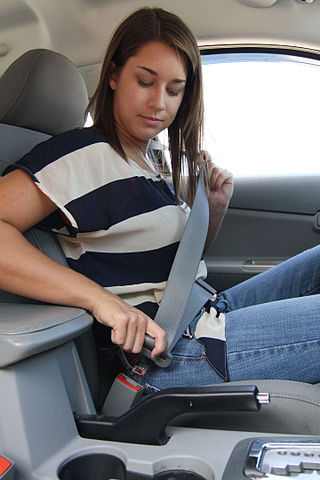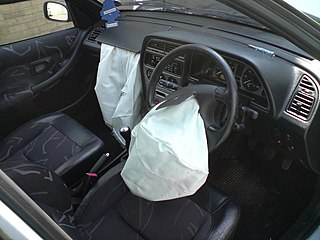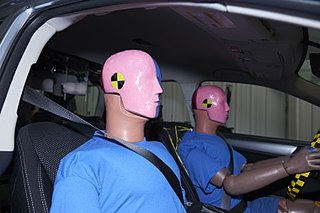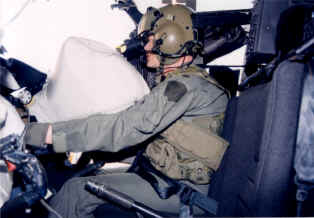
A seat belt, also known as a safety belt or spelled seatbelt, is a vehicle safety device designed to secure the driver or a passenger of a vehicle against harmful movement that may result during a collision or a sudden stop. A seat belt reduces the likelihood of death or serious injury in a traffic collision by reducing the force of secondary impacts with interior strike hazards, by keeping occupants positioned correctly for maximum effectiveness of the airbag, and by preventing occupants being ejected from the vehicle in a crash or if the vehicle rolls over.

An airbag is a vehicle occupant-restraint system using a bag designed to inflate extremely quickly, then quickly deflate during a collision. It consists of an airbag cushion, a flexible fabric bag, an inflation module, and an impact sensor. The purpose of the airbag is to provide a vehicle occupant with soft cushioning and restraint during a collision. It can reduce injuries between the flailing occupant and the interior of the vehicle.

A crash test dummy, or simply dummy, is a full-scale anthropomorphic test device (ATD) that simulates the dimensions, weight proportions and articulation of the human body during a traffic collision. Dummies are used by researchers, automobile and aircraft manufacturers to predict the injuries a person might sustain in a crash. Modern dummies are usually instrumented to record data such as velocity of impact, crushing force, bending, folding, or torque of the body, and deceleration rates during a collision.

Crumple zones, crush zones, or crash zones are a structural safety feature used in vehicles, mainly in automobiles, to increase the time over which a change in velocity occurs from the impact during a collision by a controlled deformation; in recent years, it is also incorporated into trains and railcars.

John Paul Stapp was an American career U.S. Air Force officer, flight surgeon, physician, biophysicist, and pioneer in studying the effects of acceleration forces on humans. He was a colleague and contemporary of Chuck Yeager, and became known as "the fastest man on earth". His work on Project Manhigh pioneered many developments for the US space program.

A crash test is a form of destructive testing usually performed in order to ensure safe design standards in crashworthiness and crash compatibility for various modes of transportation or related systems and components.

Automotive safety is the study and practice of automotive design, construction, equipment and regulation to minimize the occurrence and consequences of traffic collisions involving motor vehicles. Road traffic safety more broadly includes roadway design.

The European New Car Assessment Programme is a European voluntary car safety performance assessment programme based in Leuven, Belgium. Formed in 1996, the first results were released in February 1997. It was originally started by the Transport Research Laboratory for the UK Department for Transport but later backed by several European governments, as well as by the European Union (EU). Their slogan is "For Safer Cars".

The Insurance Institute for Highway Safety and Highway Loss Data Institute (IIHS-HLDI) is an American nonprofit organization. It was established in 1959, and it is noted for its safety reviews of vehicles in various simulated traffic situations, including the effectiveness of a vehicle's structural integrity and safety systems during a collision, in addition to examining improvement on such elements.
Calspan Corporation is a science and technology company founded in 1943 as part of the Research Laboratory of the Curtiss-Wright Airplane Division at Buffalo, New York. Calspan consists of four primary operating units: Flight Research, Transportation Research, Aerospace Sciences Transonic Wind Tunnel, and Crash Investigations. The company's main facility is in Cheektowaga, New York, while it has other facilities such as the Flight Research Center in Niagara Falls, New York, and remote flight test operations at Edwards Air Force Base, California, and Patuxent River, Maryland. Calspan also has thirteen field offices throughout the Eastern United States which perform accident investigations on behalf of the United States Department of Transportation. Calspan was acquired by TransDigm Group in 2023.

A side collision is a vehicle crash where the side of one or more vehicles is impacted. These crashes typically occur at intersections, in parking lots, and when two vehicles pass on a multi-lane roadway.

Crashworthiness is the ability of a structure to protect its occupants during an impact. This is commonly tested when investigating the safety of aircraft and vehicles. Different criteria are used to figure out how safe a structure is in a crash, depending on the type of impact and the vehicle involved. Crashworthiness may be assessed either prospectively, using computer models or experiments, or retrospectively, by analyzing crash outcomes. Several criteria are used to assess crashworthiness prospectively, including the deformation patterns of the vehicle structure, the acceleration experienced by the vehicle during an impact, and the probability of injury predicted by human body models. Injury probability is defined using criteria, which are mechanical parameters that correlate with injury risk. A common injury criterion is the head impact criterion (HIC). Crashworthiness is measured after the fact by looking at injury risk in real-world crashes. Often, regression or other statistical methods are used to account for the many other factors that can affect the outcome of a crash.

Head restraints are an automotive safety feature, attached or integrated into the top of each seat to limit the rearward movement of the adult occupant's head, relative to the torso, in a collision — to prevent or mitigate whiplash or injury to the cervical vertebrae. Since their mandatory introduction in some countries beginning in the late 1960s, head restraints have prevented or mitigated thousands of serious injuries.

The Hurt Report, officially Motorcycle Accident Cause Factors and Identification of Countermeasures, was a motorcycle safety study conducted in the United States, initiated in 1976 and published in 1981. The report is named after its primary author, Professor Harry Hurt.
Hugh DeHaven was an American pilot, engineer and passive safety pioneer. DeHaven survived a plane crash while training as a Royal Canadian Flying Corps pilot during the First World War, and became interested in improving human survivability in vehicle crashes. He has been called "Father of Crash Survivability".

A traffic collision, also known as a motor vehicle collision, occurs when a vehicle collides with another vehicle, pedestrian, animal, road debris, or other moving or stationary obstruction, such as a tree, pole or building. Traffic collisions often result in injury, disability, death, and property damage as well as financial costs to both society and the individuals involved. Road transport is the most dangerous situation people deal with on a daily basis, but casualty figures from such incidents attract less media attention than other, less frequent types of tragedy. The commonly used term car accident is increasingly falling out of favor with many government departments and organizations, with the Associated Press style guide recommending caution before using the term. Some collisions are intentional vehicle-ramming attacks, staged crashes, vehicular homicide or vehicular suicide.
The Bharat New Car Assessment Program, usually known as the Bharat NCAP, is a upcoming New Car Assessment Program for India. Cars sold in the country will be assigned by star ratings based on their safety performance. It will be implemented in phases, according to the plans being drawn up by the National Automotive Testing and R&D Infrastructure Project. It is the 10th NCAP in the world and is being set up by the government of India.
specialises in vehicle crashworthiness with a background in accident and injury investigation/analysis.
The GlobalNew Car Assessment Programme is a project of the Towards Zero Foundation, a UK-registered charity. The programme aims to promote the sale of safer cars in developing markets by empowering consumers with objective information about the safety of vehicles. Global NCAP supports the UN Sustainable Development Goals and the target to halve road deaths and injuries by 2030, and the full implementation of the Global Plan for the UN's Decade of Action for Road Safety especially the recommended activities for vehicles.
Small—On Safety: The Designed-In Dangers of the Volkswagen is a nonfiction book written by the Center for Auto Safety, with an introduction by Ralph Nader. The book looks at the deficiencies in the safety aspects of the vehicles sold by Volkswagen. It was published on September 11, 1972 by Grossman Publishers. The book is based on a study released in September 1971 by the Center entitled The Volkswagen: An Assessment of Distinctive Hazards. The book concluded that "the Volkswagen Beetle is the most hazardous car currently in use in significant numbers in the United States" and that "the VW microbus or van is so unsafe that it should be removed from the roads entirely."














